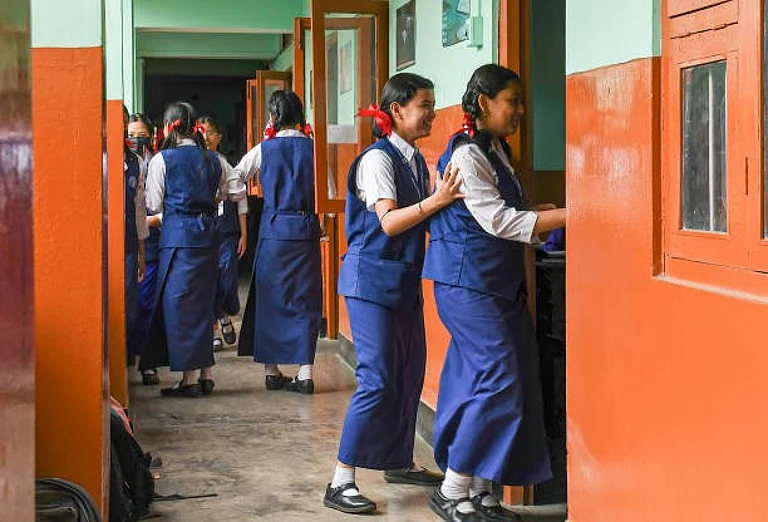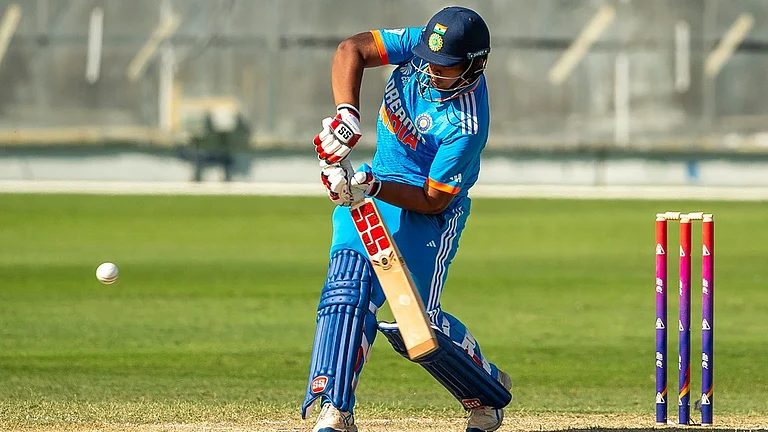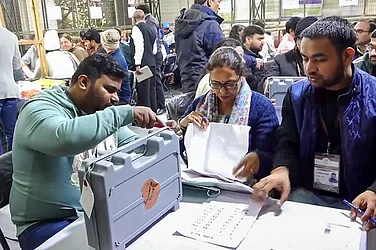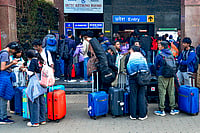
On November 11, 2024 a small, tense crowd gathered on the premises of the session's court Kasargodu, anticipation etched on their faces as they waited for the legal proceedings. Television cameras stood ready and journalists clutched their microphones, sensing the gravity of the moments about to unfold.
At two in the afternoon, Moithu and his wife Aisha, accompanied by their legal counsel, completed the necessary paperwork with trembling hands. They were then presented with a small box, its weight belying its size, much like the burden they had carried for nearly two decades. The members of the action council, who had steadfastly fought for justice alongside the elderly couple, formed a protective circle around them.
The two of them opened the box to reveal a small package wrapped in pristine white cloth. As the fabric fell away, it unveiled a child's skull that bore silent testimony to a life cut tragically short. Aisha broke down, as did Moithu, despite his attempts to maintain composure. The action council members stood in respectful silence.
This was all that remained of Moithu and Aisha’s beloved Safiya, their firstborn, who was killed at the age of 13 in 2006. After eighteen years, the skull—kept as a piece of evidence throughout the prolonged legal battle for justice—had finally been returned to her parents. This marked the close of an excruciating chapter in the lives of Moithu and Aisha, who, burdened by poverty, had reluctantly sent Safiya to work as a domestic help.
In 2006, Moithu, a daily wage labourer, and Aisha, were approached by their neighbour, Moithu Haji, with a proposal to send Safiya to work as a babysitter for a wealthy family. Despite their dire poverty, the couple initially refused. However, Moithu Haji persisted, assuring them that Safiya would also be sent to school and that her only responsibility would be babysitting the family's young children, and no other household chores required. Hoping their daughter would have the opportunity to get an education, Moithu and Aisha reluctantly agreed. Soon after, K.C. Hamsa, a contractor from Kasargod with businesses in Karnataka and Goa, and his wife Maimoona, came to their home and left with Safiya.
Initially, Moithu and Aisha kept regular contact with Safiya over the phone. However, they noticed a worrying change—Safiya, who used to speak freely, became increasingly reserved, often limiting her responses to "yes" and "no". Concerned, the couple repeatedly asked Hamsa and his family to return Safiya. Instead of complying, Hamsa took Safiya to his apartment in Goa, informing her parents that his family had relocated there and taken Safiya along. Neither Hamsa nor Maimoona had sought the parents’ permission to move their child to Goa.
Moithu and Aisha soon realised that all the promises made to them were false. Safiya was not sent to school and was forced to take on the demanding tasks of a domestic helper in addition to babysitting. Moithu repeatedly urged Hamsa to send Safiya back. However, the couple lacked the means to travel to Goa and meet their daughter in person. Each time Moithu requested her return, Hamsa would make empty promises.
On December 20, 2006, Hamsa called Moithu, asking him to come to his house in Kasargod. Hoping to finally see his daughter, Moithu rushed there, only to be told that Safiya was missing. Hamsa claimed that Safiya had been playing in the courtyard with their child when she disappeared. Heartbroken, Moithu refused to leave without Safiya. After much persuasion, Hamsa and two other men from his house accompanied him to Athur Police Station to file a missing person report. A shattered Moithu returned home after filing the complaint.
Struggling to process what had happened, Moithu couldn’t bring himself to inform Aisha that Safiya was missing. Two days later, the couple was summoned to the Athur Police Station, where Hamsa was present. The police accused Moithu of hiding Safiya for financial gain and filing a false complaint. They threatened to imprison him and locked him up in a cell. Overwhelmed by grief and shock, Aisha and their younger son broke down in tears, pleading for his release. Eventually, the officers let Moithu go.
The Action Council’s Role
“After Moithu was released from the station, he met with some of us. Understanding the seriousness of the situation, we feared that the local police would not properly investigate the case. As a result, we formed an action council led by several local activists,” says Subair Paduppu, a social activist and active member of the council.
The action council organised large protests demanding a proper investigation into Safiya's disappearance and declared an indefinite Satyagraha. “The Satyagraha lasted for 120 continuous days. Many people, including those from outside Kasargod, came to join us at the protest site. The entire local community took the issue as their own and expressed their support. We didn’t stop the Satyagraha even after the Crime Branch took over the investigation. We feared that if the pressure eased, the investigation would get nowhere,” recalls Subair, who was involved throughout.
Seven leaders of the action council—Ambalathara Kunjikrishnan, Ajith Kumar Azad, Vijayalakshmi, Abdulkhader, M. Sulphath, Narayan Periya, and Subair—together filed a petition in court to demand a proper investigation. “We were all there, but I would say that the unyielding determination and courage shown by Safiya’s mother, Aisha, was the real driving force behind our struggle,” says Subair.
The Story of the Cold-blooded Murder
After being taken in by Hamsa and Maimoona, Safiya had endured numerous hardships. She had to be a babysitter and do arduous household chores as well. She was scared and unhappy.
The judgement issued by the Kasargod Sessions Court on July 16, 2015, sentencing Hamsa to death, gives the details:
On December 15, 2006, while Maimoona and the children were away, Hamsa accidentally spilled a vessel of boiling rice water on Safiya, who was cleaning the kitchen. Despite her severe burn injuries, Hamsa avoided taking her to the hospital, fearing legal repercussions for employing a minor as a domestic worker. Deprived of medical attention, Safiya became delirious. Hamsa then took her to another apartment, where he delivered fatal blows to her neck with a chopper, resulting in her death.
To cover up the crime, he chopped up her body and the pieces were put in bags, which were carried in a car and driven down the Goa-Belgaum National Highway. Abdulla, a friend of Hamsa’s, the fourth accused in the case, also was there to aid him. While reaching a forest area, they threw the bags away, but collected them back due to the apprehension that someone had seen them. The bags were shifted to a site under the control and supervision of Abdulla at Mollem in Goa. The bags were buried in a deep pit at this location.
Five days after committing the murder, Hamsa contacted Moithu and claimed that Safiya was missing, stating that she had disappeared from his house in Kasargod. To support his story, Hamsa enlisted the help of a local police officer to fabricate evidence. He collaborated with P.N. Gopalakrishnan, the then ASI investigating Safiya's disappearance, to alter the Majoli Check Post register. The original entry of "2+1" was changed to "3+1" to falsely indicate that Safiya had accompanied Hamsa on his return journey from Goa to Kasargod.
Due to the immense pressure mounted by the action council, the investigation was handed over to the crime branch.
A Case that Rested Solely on Forensic Evidence
The investigation team had to start from scratch, as there was no direct evidence linking Hamsa to Safiya's disappearance. Early on, rumours did the rounds that Safiya had eloped with a boyfriend or that Hamsa was being falsely accused by relatives due to family disputes. The first clue came in only after one-and-a-half hours of investigation during which the investigating team kept Abdulla under close surveillance. Eventually he spilled the beans. After further grilling he disclosed that it was Hamsa who had committed the crime. Hamsa confessed that Safiya’s body had been buried near a dam site in Goa. The recovery of her remains—a skull and a few bones—became crucial evidence. Also, a strand of Safiya’s hair was recovered from their car that got a DNA match. This conclusive forensic proof played a decisive role in establishing Hamsa's guilt beyond reasonable doubt, even in the absence of eyewitnesses.
The skull was preserved in the forensic lab for further examinations, including superimposition with Safiya’s photograph. The Sessions Court deemed the crime as "rarest of the rare", sentencing Hamsa to death. Maimoona and Abdulla received three years of imprisonment for crimes including kidnapping the child and tampering with evidence. In 2020, the High Court reduced Hamsa's death sentence to life imprisonment.
“This should never happen to anyone else. That is why we fought this battle, even though nothing can ever make up for our loss,” says Moithu. On November 11, 2024, the couple finally found closure after a long and painful journey. They laid their beloved child’s mortal remains to rest in accordance with their religious rites.
The ‘signature tree’ near the Kasargod bus stand, which stood as a silent witness of 120 days of their Satyagraha in the quest for justice, has now become a part of history. This tree, named the ‘signature tree’ after playing host to the Satyagraha demanding a thorough investigation into Safiya’s disappearance, became a focal point for protests and movements. It later saw numerous campaigns, including a signature drive for compensation for endosulfan victims. Sadly, this symbol of struggles for justice was cut down in May 2022 to make way for the expansion of the national highway.













.jpg?auto=format%2Ccompress&fit=max&format=webp&w=768&dpr=1.0)















